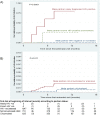Low HIV incidence in pregnant and postpartum women receiving a community-based combination HIV prevention intervention in a high HIV incidence setting in South Africa
- PMID: 28750070
- PMCID: PMC5531482
- DOI: 10.1371/journal.pone.0181691
Low HIV incidence in pregnant and postpartum women receiving a community-based combination HIV prevention intervention in a high HIV incidence setting in South Africa
Abstract
Background: Young Southern African women have the highest HIV incidence globally. Pregnancy doubles the risk of HIV acquisition further, and maternal HIV acquisition contributes significantly to the paediatric HIV burden. Little data on combination HIV prevention interventions during pregnancy and lactation are available. We measured HIV incidence amongst pregnant and postpartum women receiving a community-based combination HIV prevention intervention in a high HIV incidence setting in South Africa.
Methods: A cohort study that included HIV-uninfected pregnant women was performed. Lay community-based workers provided individualized HIV prevention counselling and performed three-monthly home and clinic-based individual and couples HIV testing. Male partners were referred for circumcision, sexually transmitted infections or HIV treatment as appropriate. Kaplan-Meier analyses and Cox's regression were used to estimate HIV incidence and factors associated with HIV acquisition.
Results: The 1356 women included (median age 22.5 years) received 5289 HIV tests. Eleven new HIV infections were detected over 828.3 person-years (PY) of follow-up, with an HIV incidence rate of 1.33 infections/100 PY (95% CI: 0.74-2.40). Antenatally, the HIV incidence rate was 1.49 infections/100 PY (95% CI: 0.64-2.93) and postnatally the HIV incidence rate was 1.03 infections/100 PY (95% CI: 0.33-3.19). 53% of male partners received HIV testing and 66% of eligible partners received referral for circumcision. Women within known serodiscordant couples, and women with newly diagnosed HIV-infected partners, adjusted hazard ratio (aHR) = 32.7 (95% CI: 3.8-282.2) and aHR = 126.4 (95% CI: 33.8-472.2) had substantially increased HIV acquisition, respectively. Women with circumcised partners had a reduced risk of incident HIV infection, aHR = 0.22 (95% CI: 0.03-1.86).
Conclusions: Maternal HIV incidence was substantially lower than previous regional studies. Community-based combination HIV prevention interventions may reduce high maternal HIV incidence in resource-poor settings. Expanded roll-out of home-based couples HIV testing and initiating pre-exposure prophylaxis for pregnant women within serodiscordant couples is needed in Southern Africa.
Conflict of interest statement
Figures
Similar articles
-
Effectiveness of community-based support for pregnant women living with HIV: a cohort study in South Africa.AIDS Care. 2016;28 Suppl 1(sup1):114-8. doi: 10.1080/09540121.2016.1148112. Epub 2016 Feb 28. AIDS Care. 2016. PMID: 26922939 Free PMC article.
-
Antiretroviral Therapy to Prevent HIV Acquisition in Serodiscordant Couples in a Hyperendemic Community in Rural South Africa.Clin Infect Dis. 2016 Aug 15;63(4):548-54. doi: 10.1093/cid/ciw335. Epub 2016 May 20. Clin Infect Dis. 2016. PMID: 27208044 Free PMC article.
-
HIV incidence, pregnancy, and implementation outcomes from the Sakh'umndeni safer conception project in South Africa: a prospective cohort study.Lancet HIV. 2019 Jul;6(7):e438-e446. doi: 10.1016/S2352-3018(19)30144-4. Epub 2019 May 31. Lancet HIV. 2019. PMID: 31160268 Free PMC article.
-
Offering pre-exposure prophylaxis for HIV prevention to pregnant and postpartum women: a clinical approach.J Int AIDS Soc. 2017 Mar 8;20(Suppl 1):21295. doi: 10.7448/IAS.20.2.21295. J Int AIDS Soc. 2017. PMID: 28361503 Free PMC article. Review.
-
Incident HIV among pregnant and breast-feeding women in sub-Saharan Africa: a systematic review and meta-analysis.AIDS. 2020 Apr 1;34(5):761-776. doi: 10.1097/QAD.0000000000002487. AIDS. 2020. PMID: 32167990 Free PMC article.
Cited by
-
Pre-exposure prophylaxis uptake and early continuation among pregnant and post-partum women within maternal and child health clinics in Kenya: results from an implementation programme.Lancet HIV. 2020 Jan;7(1):e38-e48. doi: 10.1016/S2352-3018(19)30335-2. Epub 2019 Dec 5. Lancet HIV. 2020. PMID: 31813837 Free PMC article.
-
Prevalence of undiagnosed HIV among children in South Africa, Côte d'Ivoire and Zimbabwe: a model-based analysis to inform paediatric HIV screening programmes.J Int AIDS Soc. 2022 Dec;25(12):e26045. doi: 10.1002/jia2.26045. J Int AIDS Soc. 2022. PMID: 36519674 Free PMC article.
-
Recent HIV infection among pregnant women in the 2017 antenatal sentinel cross-sectional survey, South Africa: Assay-based incidence measurement.PLoS One. 2021 Apr 14;16(4):e0249953. doi: 10.1371/journal.pone.0249953. eCollection 2021. PLoS One. 2021. PMID: 33852629 Free PMC article.
-
HIV incidence among pregnant and postpartum women in a high prevalence setting.PLoS One. 2018 Dec 28;13(12):e0209782. doi: 10.1371/journal.pone.0209782. eCollection 2018. PLoS One. 2018. PMID: 30592749 Free PMC article.
-
HIV Prevention and Sexual Health Conversations Among Women in Ending the HIV Epidemic Priority Communities: A Qualitative Exploration of Experiences and Preferences.Arch Sex Behav. 2025 Apr;54(4):1537-1553. doi: 10.1007/s10508-025-03108-3. Epub 2025 Mar 18. Arch Sex Behav. 2025. PMID: 40102279
References
-
- UNAIDS. The gap report. 2014. http://www.unaids.org/en/resources/documents/2014/20140716_UNAIDS_gap_re....
-
- Actuarial Society of South Africa. ASSA2008 AIDS and demographic model. 2011. http://www.actuarialsociety.org.za/Societyactivities/CommitteeActivities....
-
- Harrison A, Colvin CJ, Kuo C, Swartz A, Lurie M. Sustained High HIV Incidence in Young Women in Southern Africa: Social, Behavioral, and Structural Factors and Emerging Intervention Approaches. Curr HIV/AIDS Rep. 2015;12(2): 207–215. doi: 10.1007/s11904-015-0261-0 - DOI - PMC - PubMed
-
- Baxter C, Abdool Karim S. Combination HIV prevention options for young women in Africa. Afr J AIDS Res. 2016;15(2): 109–121. doi: 10.2989/16085906.2016.1196224 - DOI - PubMed
-
- Mugo NR, Heffron R, Donnell D, Wald A, Were EO, Rees H, et al. Increased risk of HIV-1 transmission in pregnancy: a prospective study among African HIV-1-serodiscordant couples. AIDS. 2011;25(15): 1887–1895. doi: 10.1097/QAD.0b013e32834a9338 - DOI - PMC - PubMed
MeSH terms
LinkOut - more resources
Full Text Sources
Other Literature Sources
Medical


